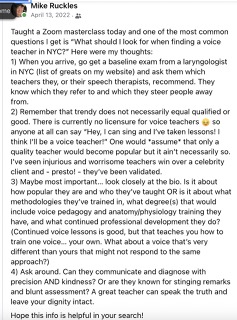One time a director I respected said after an opening night, “Dan, you know what you’re doing. You just have to trust yourself.”
It meant a lot to me. And I immediately asked in my head, “Can someone please tell me how exactly one goes about trusting oneself?”
(I would go on to several years of doing just the opposite.)
When it came to career stuff, I searched and waited for this substantial self-belief I heard folks talking about.
Believe in yourself!
Look in the mirror and say in a low breathy yoga teacher voice, “I am a powerful, successful, cosmic star of stage and screen with an EGOT and nice enough abs.”
(I did have an agent one time instruct me to pull up my shirt to assess my belly, so this was a thing.)
But this feeling of invincible confidence never alighted, and I walked around thinking something must be wrong and that I might not belong in the places I wanted to sing after all.
I mean, those folks had nicer and much more smoldery headshots.
Generating all this anxiety juice was a belief I’d picked up. Maybe it was Mr. Rogers saying I was special combined with singing “One Moment in Time” in 7th grade chorus. Whatever its origin, this credo permeated everything.
Here it is:
I have to believe in myself.
This one tripped me up for years. Still does.
Where did my self belief go? I’m sure I left it right here.
So elusive.
Whoah, I must have said that out loud because here’s a news story in my Google feed about “7 Ways to Achieve Unstoppable Belief in Yourself.”
And this online course.
Oh, and YouTube heard, too.
Thanks, nosy algorithm. You always know what to serve up so that I can deceive myself that I’m making steps toward my soul’s longing through constant input, research, and notification checking.
Seriously, though, there’s that belief, right?
I need to believe in myself.
I don’t think you do.
We waste a lot of energy and brain glucose trying to conjure a Marvel hero mind-state when we could just start repeating a lyric and seeing how it lights up in our imagination.
That would be one building block of a song you’d have added to your artistic structure, and it also adds stone and mortar to something that does indeed come in handy:
CONFIDENCE
Wait. Belief? Confidence? Samesies, right?
Nope.
Confidence comes from the Latin meaning with (con) trust (fidere).
When you trust something, there’s usually a basis for that trust.
And the basis for that trust is your skill.
And in order to build your skill, you have to show up regularly and do the things that build that skill.
And in order to show up, the only thing you need to believe is that if you keep doing the things that lead to vocal freedom, expressive honesty, and creative fulfillment, you’ll sing great, open your heart, and do work that satisfies you.
None of this requires you to believe in yourself.
In fact, as soon as you stop requiring yourself to have this assurance, you can start doing the simple (not easy) work of daily noise making, story telling, and then sharing it with folks.
And anywhere you start is fine.
One action, even if it needs some prerequisites, will reveal what you need to go back and bolster, and you can take it from there.
It’s messy. It’s frustrating. And it’s worth it.
Because while I don’t think you need to believe IN yourself, the thing that’s crucial is to believe yourself.
This means noticing when your body vibrates with excitement and possibility. And when it contracts.
And actually listening to that. It’ll lead you in all kinds of unexpected directions.
I’ve noticed lately that I’ve been ignoring my body brain in favor of my noggin brain, and it’s caused a lot of futile trying and anxiety.
When I’ve tuned in and acknowledged what my body’s vibing — that I want to share more singing in more places — I don’t know how it’s all happening, but things are already flowing.
I’ll keep you posted on that.
In the meantime, please take a sec to check in with your own body. Is the path you picked feeling good in your cells? It’s not a joke. You came to the planet with a good guidance system. I invite us to use it.
Because it’s true — there is only one you and only one me. And folks need to hear the story only we can sing.
Love much,
Dan
PSHere’s a video about how I’m finding the key for “I Ain’t Gonna Let You Break My Heart Again.” I also talk about the value of gibberish and also one of the vocal pitfalls we theatre singers fall into when we sing contemp/commercial styles. (Complete with a pretty adorable Noah and Jude appearance.)
PPS I signed the contract and everything — I will be singing at The Green Room 42 with Scott Nicholas on ? on Saturday, Oct 7 at 1pm.
Tickets aren’t live yet, but they start at $20. There’ll be a live stream, too, if you can’t get your body to NYC. Just click here to add to your calendar 🙂
PPPS This short from Tim Ferris’s interview with Brené Brown is not playing. It’s a call to all of us that the armor is no longer serving us.
